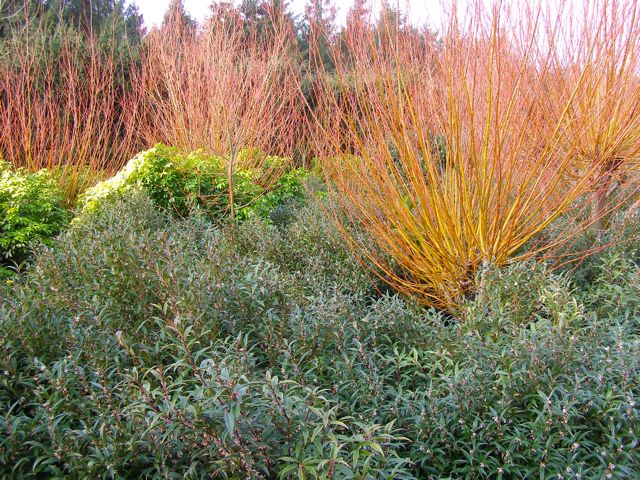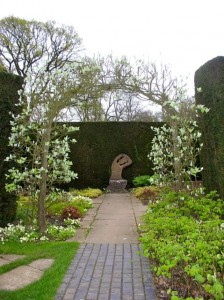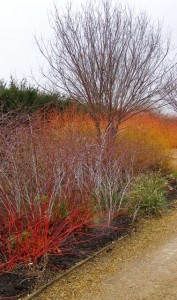
The pollard, the stooling and the time of the coppice are nearly here. Cold February days are the viewing time for low light levels playing on coloured stems of last year’s growth.
Amongst the best are the willows which can be kept small and lively by the annual chop, right back to base. This makes them a very good choice as a fake tree for the diminutive garden plot. ( A subject which I am going to write a post on soon.) Here is a willow
Salix alba ‘Britzensis” bunked up with
Sarccoccoa humilis, with a headboard of yew behind. The gingery whiskery stems have to be cut every year to promote the eye-searing redhead colour.

A plantsman’s trick is the use of the dark back-drop to excite the eye. An ocular equivalent of inducing drooling, pavlovian-style. See how well this works with the yew hedge as a solid base with an arch of
Sorbus aria training the eye on itself and backdrop with the statute. This juxtapostion, more tasty than a green fruit pastille is a scene from the gardens at Kiftsgate.
Anyway, this stooling malarchy - should you cut high or low? The pollard is done at a height to get above the chin reach of the browsing cattle. The willows round our town lake get a crude regular chop in this manner. The other way to go about this, is to cut right back into the base of the plant. This is called coppicing and the action makes a stool at ground level which kick-starts vigorous regrowth. Woodland managed by these means will keep the trees young and alive for hundreds of years.

From the gardener’s eye view, such treatment of stems will give intense winter colour. I am not going to reel out a long shopping list. Anyone with half a vegetation-savvy gaze will have noticed jewelled stems of dogwoods on roundabouts or in carparks. But we can do even better than this. Be on the lookout for the
Salix alba var. vitellina “Yelverton” for yellow and
Salix daphnoides, for
a rich plum black with an overlay of grape-like bloom.
 The pollard, the stooling and the time of the coppice are nearly here. Cold February days are the viewing time for low light levels playing on coloured stems of last year’s growth.
Amongst the best are the willows which can be kept small and lively by the annual chop, right back to base. This makes them a very good choice as a fake tree for the diminutive garden plot. ( A subject which I am going to write a post on soon.) Here is a willow Salix alba ‘Britzensis” bunked up with Sarccoccoa humilis, with a headboard of yew behind. The gingery whiskery stems have to be cut every year to promote the eye-searing redhead colour.
The pollard, the stooling and the time of the coppice are nearly here. Cold February days are the viewing time for low light levels playing on coloured stems of last year’s growth.
Amongst the best are the willows which can be kept small and lively by the annual chop, right back to base. This makes them a very good choice as a fake tree for the diminutive garden plot. ( A subject which I am going to write a post on soon.) Here is a willow Salix alba ‘Britzensis” bunked up with Sarccoccoa humilis, with a headboard of yew behind. The gingery whiskery stems have to be cut every year to promote the eye-searing redhead colour.
 A plantsman’s trick is the use of the dark back-drop to excite the eye. An ocular equivalent of inducing drooling, pavlovian-style. See how well this works with the yew hedge as a solid base with an arch of Sorbus aria training the eye on itself and backdrop with the statute. This juxtapostion, more tasty than a green fruit pastille is a scene from the gardens at Kiftsgate.
Anyway, this stooling malarchy - should you cut high or low? The pollard is done at a height to get above the chin reach of the browsing cattle. The willows round our town lake get a crude regular chop in this manner. The other way to go about this, is to cut right back into the base of the plant. This is called coppicing and the action makes a stool at ground level which kick-starts vigorous regrowth. Woodland managed by these means will keep the trees young and alive for hundreds of years.
A plantsman’s trick is the use of the dark back-drop to excite the eye. An ocular equivalent of inducing drooling, pavlovian-style. See how well this works with the yew hedge as a solid base with an arch of Sorbus aria training the eye on itself and backdrop with the statute. This juxtapostion, more tasty than a green fruit pastille is a scene from the gardens at Kiftsgate.
Anyway, this stooling malarchy - should you cut high or low? The pollard is done at a height to get above the chin reach of the browsing cattle. The willows round our town lake get a crude regular chop in this manner. The other way to go about this, is to cut right back into the base of the plant. This is called coppicing and the action makes a stool at ground level which kick-starts vigorous regrowth. Woodland managed by these means will keep the trees young and alive for hundreds of years.
 From the gardener’s eye view, such treatment of stems will give intense winter colour. I am not going to reel out a long shopping list. Anyone with half a vegetation-savvy gaze will have noticed jewelled stems of dogwoods on roundabouts or in carparks. But we can do even better than this. Be on the lookout for the Salix alba var. vitellina “Yelverton” for yellow and Salix daphnoides, for a rich plum black with an overlay of grape-like bloom.
From the gardener’s eye view, such treatment of stems will give intense winter colour. I am not going to reel out a long shopping list. Anyone with half a vegetation-savvy gaze will have noticed jewelled stems of dogwoods on roundabouts or in carparks. But we can do even better than this. Be on the lookout for the Salix alba var. vitellina “Yelverton” for yellow and Salix daphnoides, for a rich plum black with an overlay of grape-like bloom. 